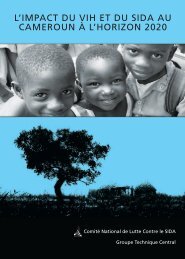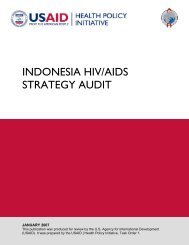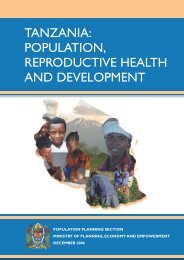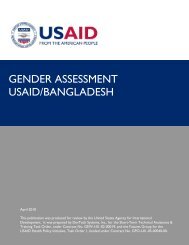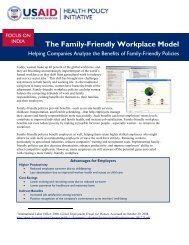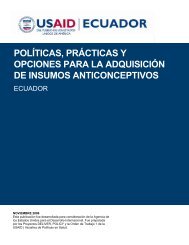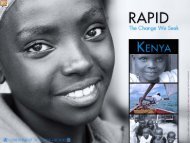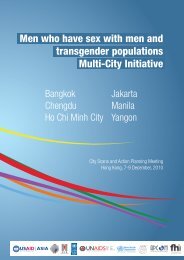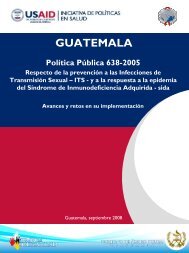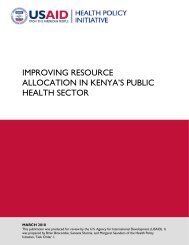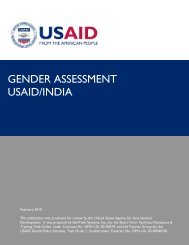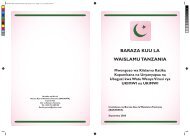LIVELIHOOD OPTIONS FOR GIRLS: - Health Policy Initiative
LIVELIHOOD OPTIONS FOR GIRLS: - Health Policy Initiative
LIVELIHOOD OPTIONS FOR GIRLS: - Health Policy Initiative
- No tags were found...
Create successful ePaper yourself
Turn your PDF publications into a flip-book with our unique Google optimized e-Paper software.
APPENDIX A: PROGRAMMING MATRIXProgramming Framework for Livelihood Program and Economic Strengthening Options for Adolescents 1Type and Description Participant Socioeconomic 2 Sample Programs and Evaluations ofElements of Success Cautionsof Program Profile Brief Description 3 Actual ProgramsAsset TransfersConditional Cash • Target the neediest • Some studies show that • Youth ages 10–19 at • The Kenya UNICEF • Programs that keep girlsTransfers (CCTs)— households. lump sum payments can risk of dropping out program conditions include in school have been shownmonetary grants to poor lead to investments in of school—especially immunizing infants; regular• Link conditionalities toto be particularly effectivefamilies in exchange for productive assets; others secondary school—because growth monitoring, anddesired outcomes forat delaying marriage anddemonstrable actions that show that a large pay-out of economic pressures to Vitamin A supplementationadolescents (e.g., stayingpreventing pregnancy;benefit children, such as may not benefit the child. generate income for the of children ages 1–5; schoolin school, attendancethere is evidence thatregular school attendance household. attendance for childrenat vocational and life skills • Some cash transfer programsin-school adolescent girlsor basic preventative ages 6–17; and attendingtraining, etc.).have led communitiesare less at risk of HIVhealthcare. awareness sessions onto hide their capacity tothan their unmarried and• Give adolescents some reproductive health and• Unconditional Cashfunction independently ofmarried peers who are outcontrol over funds (e.g., HIV for adolescents.Transfers—same asoutside resources.of school.money for transport to andabove but without• The Mexican Governmentfrom school, books, school • Avoid conditional cash• A study of a cash transferconditionality.Program PROGRESA/supplies, etc.). transfer programs whenprogram in Brazil showedOportunidades similarlythe supply of services andthat while these programs• Provide incentives forallocated cash paymentsimplementation capacity aredid not significantlygraduation and future-to poor rural families whoinsufficient.decrease child labor, theyoriented investments.participated in healthdid have a positive effect• Avoid providing benefits toand nutritional services• For effective monitoring,on school attendancefamilies that already receiveand education and keptcollect baseline informationtheir children in school.(Cardoso and Souza,before payments are made.assistance through otherPROGRESA/ Oportunidades2003).projects or agencies.targeted youth ages 7–18 • A study of cash transfer• Monitor regularly beginning and focused on females by programs in Hondurasimmediately after the offering larger educational concluded that externallydistribution to get accurate grants to them, particularly financed programs thatinformation on its use. those in secondary school. enforce human capital-• Assess the impact on localBy increasing continuation related co-responsibilitiesrates from primaryeconomic dynamics (intrafor just a few years shouldto secondary school,and inter-household) beforenot expect to induce majorPROGRESA increased theproviding cash resources,long-term behavioralenrollment of girls enteringwith particular focus onchanges (Moore, 2008).secondary school by 20%whether adolescents have (Skoufias, 2005).some discretionary controlover the resources.• The Suubi (Hope) Project inUganda transfers cash intoa savings account to pay forsecondary school education.The project makes a 2 to 1match of any savingsdeposited by an adolescent’scaregiver (AED, 2008).1Columns one through three are adapted from “USAID Field Brief No. 3: Economic Strengthening for Vulnerable Children,” developed by AED and Save the Children under the Leader with Associates mechanism(Cooperative Agreement No. EEM-A-00-06-00001-00).2“Socioeconomic” refers to social and economic identifiers such as age, sex, gender, ethnicity, race, education, residential locality, and class.3Almost all projects cited here are linked or multisectoral projects that combine some dimension of economic/livelihood strengthening with HIV/AIDS/reproductive health education, life skills training, and17 | gender/girls’ empowerment.



